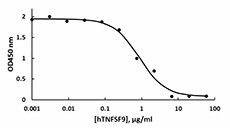- Regulatory Status
- RUO
- Other Names
- CD137L, 4-1BB-L, 4-1BBL, 41BBL, 4-1BB Ligand, 41BB Ligand

-

The recombinant human TNFSF9, when immobilized with anti-CD3 antibody, is able to inhibit the secretion of IFN-γ by activated human T cells in a dose dependent manner. The ED50 is 0.4 - 4.0 µg/ml. The results may vary depending on human donors.
| Cat # | Size | Price | Quantity Check Availability | ||
|---|---|---|---|---|---|
| 750002 | 10 µg | $147.00 | |||
| 750004 | 25 µg | $253.00 | |||
| 750006 | 100 µg | $686.00 | |||
Select size of product is eligible for a 40% discount! Promotion valid until December 31, 2024. Exclusions apply. To view full promotion terms and conditions or to contact your local BioLegend representative to receive a quote, visit our webpage.
TNFSF9, also known as 4-1BBL and CD137L, is a type II transmembrane glycoprotein that belongs to the TNF superfamily. This protein is mainly expressed on antigen presenting cells (APC), and on B lymphocytes particularly. The interaction between TNFSF9 and its receptor, CD137, which is mainly expressed on T cells, leads to the activation of cytotoxic T cells. In addition, TNFSF9-CD137 interaction can reactivate anergic T lymphocytes and induce T cell proliferation. This molecule plays a role in optimal CD8 T cell response. Interestingly, it appears that TNFSF9 is able to act as a costimulatory molecule without the engagement of other costimulatory molecules such as CD28. TNFSF9 signaling on T cells has also been shown to limit T cell activation. CD137L is upregulated in peripheral CD14+ monocytes of chronic hepatitis B patients and is associated with liver cirrhosis. Human TNFSF9 shares 36% of its amino acid sequence with its murine counterpart. Mice deficient of TNFSF9 are susceptible to develop B-cell lymphomas.
Product Details
- Source
- Human TNFSF9, amino acids (Arg71-Glu254) (Accession# NP_003802), was expressed in 293E cells with a N-terminal His tag.
- Molecular Mass
- The 193 amino acid recombinant protein has a predicted molecular mass of approximately 20.5 kD. The protein migrates at about 22 kD in DTT-reducing conditions by SDS-PAGE. The predicted N-terminal amino acid is His.
- Purity
- >97%, as determined by Coomassie stained SDS-PAGE.
- Formulation
- 0.22 µm filtered protein solution is in PBS, pH 7.2.
- Endotoxin Level
- Less than 1.0 EU per µg of protein as determined by the LAL method.
- Concentration
- 10 and 25 µg sizes are bottled at 200 µg/mL. 100 µg size and larger sizes are lot-specific and bottled at the concentration indicated on the vial. To obtain lot-specific concentration and expiration, please enter the lot number in our Certificate of Analysis online tool.
- Storage & Handling
- Unopened vial can be stored between 2°C and 8°C for up to 2 weeks, at -20°C for up to six months, or at -70°C or colder until the expiration date. For maximum results, quick spin vial prior to opening. The protein can be aliquoted and stored at -20°C or colder. Stock solutions can also be prepared at 50 - 100 µg/mL in appropriate sterile buffer, carrier protein such as 0.2 - 1% BSA or HSA can be added when preparing the stock solution. Aliquots can be stored between 2°C and 8°C for up to one week and stored at -20°C or colder for up to 3 months. Avoid repeated freeze/thaw cycles.
- Activity
- Human TNFSF9, when immobilized with anti-CD3 antibody, is able to inhibit IFN-γ secretion in human T cells in a dose-dependent manner with an ED50 of 0.4 - 4.0 µg/mL. Results may vary depending on human donors.
- Application
-
Bioassay
- Application Notes
-
BioLegend carrier-free recombinant proteins provided in liquid format are shipped on blue-ice. Our comparison testing data indicates that when handled and stored as recommended, the liquid format has equal or better stability and shelf-life compared to commercially available lyophilized proteins after reconstitution. Our liquid proteins are verified in-house to maintain activity after shipping on blue ice and are backed by our 100% satisfaction guarantee. If you have any concerns, contact us at tech@biolegend.com.
Antigen Details
- Structure
- Monomer.
- Distribution
-
Constitutively expressed on a fraction of dendritic cells (DCs). Inducible on activated monocytes, macrophages, B cells, a small fraction of T cells, epithelial, and endothelial cells.
- Function
- TNFSF9 plays roles in cytotoxic T cell activation, T cell proliferation, and apoptosis.
- Interaction
- Activated T cells, natural killer cells (NK), macrophages, and dedritic cells.
- Ligand/Receptor
- CD137.
- Bioactivity
- TNFSF9 immobilized with anti-CD3 antibody is able to inhibit the secretion of IFN-γ by activated T cells.
- Biology Area
- Immunology, Costimulatory Molecules
- Molecular Family
- CD Molecules, Immune Checkpoint Receptors, Soluble Receptors
- Antigen References
-
1. Vinay DS and Kwon BS. 1998. Semin. Immunol. 10:481.
2. Watts TH. 2005. Annu. Rev. Immunol. 23:23.
3. Pollok KE, et al. 1994. Eur. J. Immunol. 24:367.
4. Wang J, et al. 2010. J. Immunol. 185:7654.
5. Eun SY, et al. 2014. J. Immunol. 194:134.
6. Spencer AJ, et al. 2014. PLoS One 9:e105520.
7. Locatelli F. 2009. Blood 114:2208. - Gene ID
- 8744 View all products for this Gene ID
- UniProt
- View information about TNFSF9 on UniProt.org
